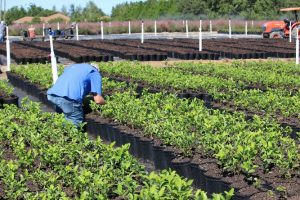Authors: Liz Felter, Ph.D., and Caroline R. Warwick, M.S.
Integrated Pest Management (IPM) is a holistic approach to managing insects, mites, pathogens, nematodes, weeds, and other pests in which multiple techniques, concepts, and practices are implemented throughout the entire production period of the crop.

Integrated is the key word: it means combining a variety of pest management techniques, concepts, and practices that can either prevent pest introduction, eradicate pests, or reduce pest populations to lessen their economic and environmental impact while maintaining plant quality. Some of these practices are preventative methods, such as good sanitation including weed control, removal of plant debris, or disinfecting tools, wearing clean work clothes as well as sound cultural practices including fertilization, irrigation, and pruning. Other practices, like the introduction of beneficial insects, are implemented specifically to manage existing pest problems. Management activities that affect pests and diseases encompass a broad range of measures, and include regulation of irrigation timing and amount, alteration of the relative humidity level in the greenhouse, or application of biological control agents to preserve beneficial organisms and reduce environmental contamination.
Restricted labeling of pesticides, pest resistance, safety to nursery personnel, and protecting the environment are all reasons that encourage nurseries to seek forms of pest control other than scheduled, preventative, nursery-wide pesticide applications. IPM is not the complete abandonment of traditional pesticides, but rather their strategic use and careful coordination with other pest management practices. This approach allows many practices to be more efficiently utilized and often in decreasing amounts.
Scouting, or monitoring, is one of the most important principles of IPM and is the foundation of any IPM program. Scouts can detect pests early such as insects, diseases, weed seedlings, and other problems through routine monitoring before it becomes a larger problem. Scouting is much like data collection and analysis – it provides an overview and raw data by which preventative and curative pest management options are chosen. The timely detection of pests and accurate assessment of population densities are fundamental to IPM decision-making. Identifying pests’ natural enemies is another integral part of the IPM process. Early detection of pests enables the nursery to reduce plant damage, improve plant quality, reduce production costs, avoid production delays, and increase profits. Continuous detection efforts and accurate record-keeping increase the ability to anticipate and schedule activities related to pest management. Low pest populations are easier to control, and detection should be followed closely with an appropriate management tactic when necessary to prevent pest outbreaks. In some situations, small pest populations can be ignored and are even useful in sustaining populations of beneficial insects. Some pest infestations disappear due to beneficial arthropods or pathogens.
Crop scouting provides increased awareness of pest presence, activity, and management. Scouting addresses the real needs of the crop, which improves pesticide use by eliminating routine and unnecessary applications. This assures that pesticides are applied at the proper stage of the life cycle to insure maximum efficacy or how well an application works. Scouts also collect information to evaluate the effectiveness of management tactics, which further guides IPM program development.
 1
1
